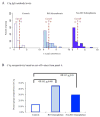Complement C1q formation of immune complexes with milk caseins and wheat glutens in schizophrenia
- PMID: 22801085
- PMCID: PMC3465075
- DOI: 10.1016/j.nbd.2012.07.005
Complement C1q formation of immune complexes with milk caseins and wheat glutens in schizophrenia
Abstract
Immune system factors including complement pathway activation are increasingly linked to the etiology and pathophysiology of schizophrenia. Complement protein, C1q, binds to and helps to clear immune complexes composed of immunoglobulins coupled to antigens. The antigenic stimuli for C1q activation in schizophrenia are not known. Food sensitivities characterized by elevated IgG antibodies to bovine milk caseins and wheat glutens have been reported in individuals with schizophrenia. Here, we examined the extent to which these food products might comprise the antigen component of complement C1q immune complexes in individuals with recent onset schizophrenia (n=38), non-recent onset schizophrenia (n=61) and non-psychiatric controls (n=63). C1q seropositivity was significantly associated with both schizophrenia groups (recent onset, odds ratio (OR)=8.02, p≤0.008; non-recent onset, OR=3.15, p≤0.03) compared to controls (logistic regression models corrected for age, sex, race and smoking status). Casein- and/or gluten-IgG binding to C1q was significantly elevated in the non-recent onset group compared to controls (OR=4.36, p≤0.01). Significant amounts of C1q-casein/gluten-related immune complexes and C1q correlations with a marker for gastrointestinal inflammation in non-recent onset schizophrenia suggests a heightened rate of food antigens in the systemic circulation, perhaps via a disease-associated altered intestinal permeability. In individuals who are in the early stages of disease onset, C1q activation may reflect the formation of immune complexes with non-casein- or non-gluten-related antigens, the presence of C1q autoantibodies, and/or a dissociated state of immune complex components. In conclusion, complement activation may be a useful biomarker to diagnose schizophrenia early during the course of the disease. Future prospective studies should evaluate the impacts of casein- and gluten-free diets on C1q activation in schizophrenia.
Copyright © 2012 Elsevier Inc. All rights reserved.
Figures



Similar articles
-
Dietary antigens, epitope recognition, and immune complex formation in recent onset psychosis and long-term schizophrenia.Schizophr Res. 2011 Mar;126(1-3):43-50. doi: 10.1016/j.schres.2010.12.001. Epub 2011 Jan 6. Schizophr Res. 2011. PMID: 21211944
-
Maternal complement C1q and increased odds for psychosis in adult offspring.Schizophr Res. 2014 Oct;159(1):14-9. doi: 10.1016/j.schres.2014.07.053. Epub 2014 Sep 4. Schizophr Res. 2014. PMID: 25195065 Free PMC article.
-
IgG dynamics of dietary antigens point to cerebrospinal fluid barrier or flow dysfunction in first-episode schizophrenia.Brain Behav Immun. 2015 Feb;44:148-58. doi: 10.1016/j.bbi.2014.09.009. Epub 2014 Sep 20. Brain Behav Immun. 2015. PMID: 25241021 Free PMC article.
-
Autoimmune diseases, gastrointestinal disorders and the microbiome in schizophrenia: more than a gut feeling.Schizophr Res. 2016 Sep;176(1):23-35. doi: 10.1016/j.schres.2014.06.027. Epub 2014 Jul 15. Schizophr Res. 2016. PMID: 25034760 Free PMC article. Review.
-
Complement component c1q and anti-c1q antibodies in theory and in clinical practice.Scand J Immunol. 2008 May;67(5):423-30. doi: 10.1111/j.1365-3083.2008.02089.x. Epub 2008 Mar 17. Scand J Immunol. 2008. PMID: 18363591 Review.
Cited by
-
Back to the Future: The Role of Infections in Psychopathology. Focus on OCD.Clin Neuropsychiatry. 2022 Aug;19(4):248-263. doi: 10.36131/cnfioritieditore20220407. Clin Neuropsychiatry. 2022. PMID: 36101642 Free PMC article.
-
Anti-gluten immune response following Toxoplasma gondii infection in mice.PLoS One. 2012;7(11):e50991. doi: 10.1371/journal.pone.0050991. Epub 2012 Nov 29. PLoS One. 2012. PMID: 23209841 Free PMC article.
-
The promise of biological markers for treatment response in first-episode psychosis: a systematic review.Schizophr Bull. 2015 May;41(3):559-73. doi: 10.1093/schbul/sbv002. Epub 2015 Mar 10. Schizophr Bull. 2015. PMID: 25759473 Free PMC article.
-
A Preliminary Genetic Analysis of Complement 3 Gene and Schizophrenia.PLoS One. 2015 Aug 25;10(8):e0136372. doi: 10.1371/journal.pone.0136372. eCollection 2015. PLoS One. 2015. PMID: 26305563 Free PMC article.
-
The complement system: a gateway to gene-environment interactions in schizophrenia pathogenesis.Mol Psychiatry. 2017 Nov;22(11):1554-1561. doi: 10.1038/mp.2017.151. Epub 2017 Aug 1. Mol Psychiatry. 2017. PMID: 28761078 Free PMC article. Review.
References
-
- Benros ME, Nielsen PR, Nordentoft M, Eaton WW, Dalton SO, Mortensen PB. Autoimmune diseases and severe infections as risk factors for schizophrenia: A 30-year population-based register study. Am J Psychiatry. 2011;168:1303–10. - PubMed
-
- Boulanger LM. Immune proteins in brain development and synaptic plasticity. Neuron. 2009;64:93–109. - PubMed
-
- Boyajyan A, Khoyetsyan A, Tsakanova G, Sim RB. Cryoglobulins as indicators of upregulated immune response in schizophrenia. Clin Biochem. 2008;41:355–60. - PubMed
Publication types
MeSH terms
Substances
Grants and funding
LinkOut - more resources
Full Text Sources
Other Literature Sources
Medical

